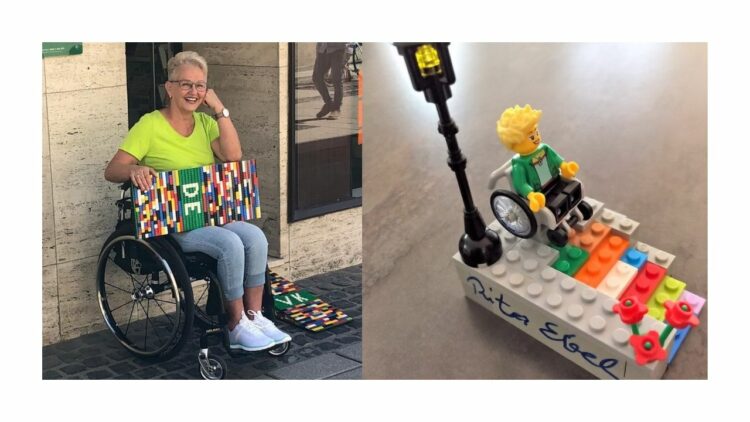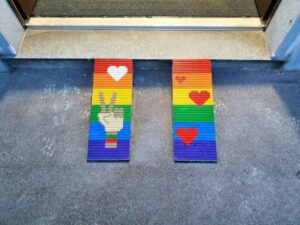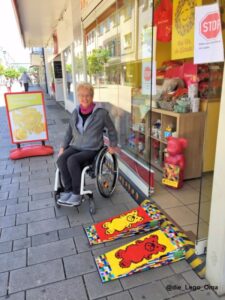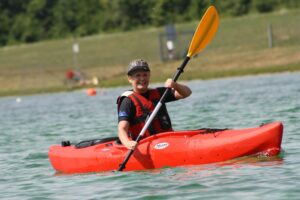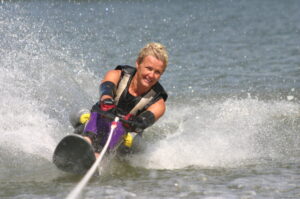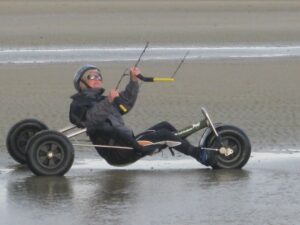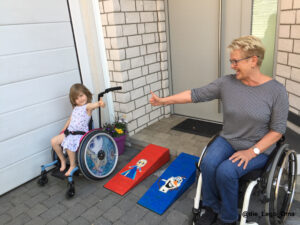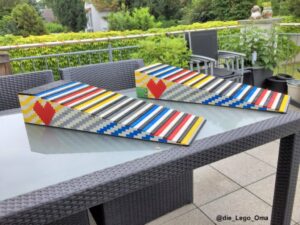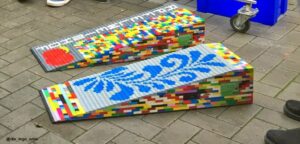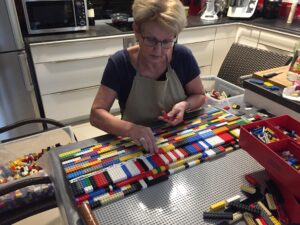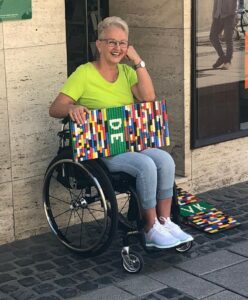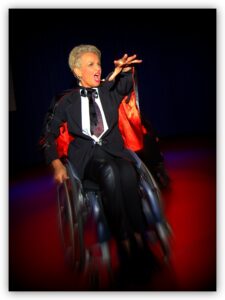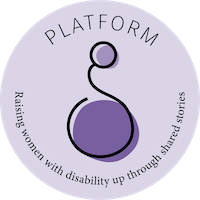For many of us with disabilities, we spend much of our time working out creative ways to increase access to places and spaces not always designed to include us. Sometimes it is navigating sets of stairs leading to places we would like to go ( involving undignified and embarrassing lifts from kind strangers or family members) for meals, movies, celebrations, or planning ways to be able to go to the bathroom when out in places that do not cater for our basic needs.
Often, we have to get creative to get where we want or need to be…I have spent many a time transferring in a range of creative ways to access a toilet with a narrow door. I have bumped backwards down a few stairs, I have “bummed” my way across floors, in order to get where I need to be, sat in doorways of storefronts calling for assistance, denied entry by a single step or alternatively, chosen to stay home, or to go elsewhere depending on my motivation, and my energy levels at the time.
Much of my life has been spent working to educate and advocate for greater access and inclusion to help our community have the tools and the knowledge to be more welcoming and value the diversity of all of us. The solutions to access are often simple and easily implemented, they just require some meaningful conversations, willingness, and sometimes creativity.
I felt a sense of joy and it made me smile, when I learned about the way in which one woman is changing her community and that of others around the world. Rita Ebel uses an iconic toy brand as a low-tech solution to solving access issues.
Meet Rita, known internationally as the “Lego Granma” who is changing her world, one Lego block at a time!
Tell us about yourself
My name is Rita Ebel, I am 63 years old and live in Hanau (Germany) near Frankfurt. I had a self-inflicted car accident 26 years ago and have had incomplete paraplegia since then.
What has been your journey of disability?
At the beginning it was a shock that I, who always did sports and was always on the road, should sit in a wheelchair for the rest of my life. So I thought, I have to do something to get out of the wheelchair again. I still haven’t managed it, but through a lot of discipline and constant practice I can walk short distances on supports. This has given me quite a bit of freedom again. The worst thing was always to be dependent on others, so I wanted to do a lot of things on my own again as quickly as possible, and I have managed to do so.
What do you do with yourself?
I receive a pension and go to work once a week in a medical supply store. I am a reading mentor in a kindergarten, I do “perspective changes” with schools, kindergartens or companies, i.e. I provide wheelchairs to “pedestrians” and give them tasks (e.g. driving the bus, shopping, etc.) so that they get to know the world of a wheelchair user. I do or did a lot of sports. Handcycling, table tennis, kayaking, water skiing (I was once vice European champion in trick skiing), kiting, standup paddling, musical performer.
How has your disability impacted on what you do?
I always wanted to be seen as a human being and not as a “disabled person”. I have found that it is important to accept myself in this situation and to approach people. I am a positive, cheerful person by nature and I wanted to stay that way at all costs. I have managed to do that and that makes it easier for other people to get in touch with me.
“I always wanted to be seen as a human being and not as a “disabled person“
Your “Lego Ramps” have become quite famous, what was the motivator for creating a ramp made from Lego?
I read a report in a trade magazine for paraplegics by Corinna from Bielefeld who builds ramps from Lego bricks. There was a picture of a power wheelchair driving over such a ramp. I was totally enthusiastic and wanted to do the same here in Hanau.
What type of impact have Lego ramps had on your community?
In the beginning, I set this up together with the organization “Menschen in Hanau” (People in Hanau). The idea was accepted by the city from the beginning. The residents are now much more concerned about accessibility due to the attention the Lego ramps attract and now see steps that they didn’t notice before.
How do you get access to the Lego to make your creations, and how do you distribute them in the community?
In the beginning, we only distributed flyers and posters in Hanau and asked for donations. I had a small stand at each campaign in the city to advertise the ramps. After the 1st ramp was in place, donations and construction requests started coming in on their own. Meanwhile they come from all over Germany and even a donation from Italy and Spain. Through our internet presence on Facebook and Instagram, the idea has spread quickly and I have already sent our building instructions over 400 times in 8 different languages around the world. Stores ask me if I can build a ramp for them and if it is only 1 step to max. 18 cm height, we build the ramps voluntarily and free of charge. Meanwhile our ramps are in many cities in Germany and 1 in Paris and 1 in Austria. Within one and a half years we have built 44 ramps.
Are there things about you that people misunderstand because of your disability?
In the beginning, I always had the feeling that people talked more to my companion than to me. In one situation I had to point out that I am not mentally handicapped just because I am in a wheelchair and that people can talk to me normally.
What is one thing, experience or person you have had that completely changed your life?
3 days after my accident, when I was starting to think about my future life, I was thinking about my own funeral. I saw from the grave the people who were important to me. Parents, daughter, siblings, friends and could feel their despair that I was no longer there. It was then I realized that the most important thing was that I was still alive. No matter if I have to spend my future in a wheelchair, the main thing is that I still exist. From then on, I accepted my situation and never questioned it again.
“…the most important thing was that I was still alive. No matter if I have to spend my future in a wheelchair, the main thing is that I still exist”
Is there a single piece of technology that makes your life easier? Why?
The electric drive (Smart Drive) for my wheelchair. I can switch it on via a Bluetooth wristband if I don’t have as much power or there’s a slope. But I can also ignore it and pull it along behind me. This gives me a much greater range of motion.
What’s one thing about you that surprises people?
That despite my situation I am always friendly, funny and motivated for everything. And have done or still do a lot of different types of sports.
For what are you most grateful today?
That 8 years ago I found a new partner (my current husband) who just takes me as I am.
Knowing what you know now, what advice would you give your 18-year-old self?
Live your life and try to enjoy every day. There is hardly a situation, as bad as it may seem at first, that does not have something positive.
Is there something that you would like people to know about you or about people with disability that they might not know?
That paraplegics not only cannot walk, but also have many other problems such as bladder and bowel paralysis. Such things are talked about far too little, but these are exactly the things that make life so difficult.
Best advice that you would like to share with other women with disabilities?
Do not hide. You are attractive even in a wheelchair and dress accordingly.
For what would you most like to be remembered for?
For cheerfulness and courage to face life
Do you have a way for people to connect or follow you that you would like to share?
Facebook: Die Lego-Oma Rita Ebel
Instagram: die_lego_oma

